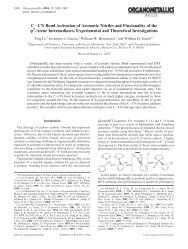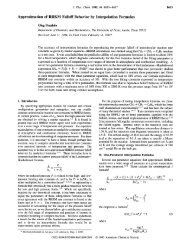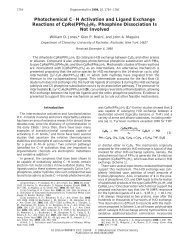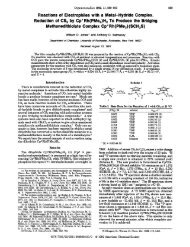Isotope Effects in C-H Bond Activation Reactions by Transition Metals
Isotope Effects in C-H Bond Activation Reactions by Transition Metals
Isotope Effects in C-H Bond Activation Reactions by Transition Metals
You also want an ePaper? Increase the reach of your titles
YUMPU automatically turns print PDFs into web optimized ePapers that Google loves.
<strong>Isotope</strong> <strong>Effects</strong> <strong>in</strong> C-H <strong>Bond</strong> <strong>Activation</strong><br />
Jones<br />
Scheme 1 Scheme 2<br />
plex. Furthermore, s<strong>in</strong>ce virtually all of this isotope effect<br />
would likely be associated with the C-H/C-D bondmak<strong>in</strong>g/bond-break<strong>in</strong>g<br />
step, rather than the alkane dissociation<br />
step, the overall isotope effect for alkane loss<br />
was attributed to an <strong>in</strong>verse equilibrium isotope effect (i.e.,<br />
H/D<br />
K eq < 1) separat<strong>in</strong>g the alkyl hydride complex from the<br />
σ-alkane complex.<br />
One explanation for the orig<strong>in</strong> of the <strong>in</strong>verse equilibrium<br />
isotope is that the σ-alkane complex conta<strong>in</strong>s an<br />
<strong>in</strong>tact, strong C-H or C-D bond, whereas the alkyl<br />
hydride complex has a weaker M-H or M-D bond.<br />
Consideration of the zero-po<strong>in</strong>t energy differences associated<br />
with the stretch<strong>in</strong>g frequencies for these bonds<br />
leads to the expectation of an <strong>in</strong>verse equilibrium isotope<br />
effect. 13 That is, with metal-hydrogen stretch<strong>in</strong>g<br />
frequencies be<strong>in</strong>g about two-thirds those of aliphatic C-H<br />
bonds, a smaller difference <strong>in</strong> zero-po<strong>in</strong>t energies is<br />
expected <strong>in</strong> the alkyl hydride complex compared to the<br />
σ-alkane complex. There are two possibilities to be<br />
considered for the transition state separat<strong>in</strong>g these two<br />
complexes. In one case, shown <strong>in</strong> Scheme 3a, the zeropo<strong>in</strong>t<br />
energy difference <strong>in</strong> the transition state is assumed<br />
to be <strong>in</strong>termediate between those of the reactant and<br />
product. In the second case, shown <strong>in</strong> Scheme 3b, the<br />
C-H/C-D stretch<strong>in</strong>g frequency is assumed to disappear<br />
as it becomes the reaction coord<strong>in</strong>ate to break the bond.<br />
In the first case (a), one expects an <strong>in</strong>verse k<strong>in</strong>etic isotope<br />
effect for the conversion of the alkyl hydride complex to<br />
the σ-alkane complex (k RCH /k RCD ), but a normal k<strong>in</strong>etic<br />
isotope effect for the reverse reaction (k OCH /k OCD ). In the<br />
second case (b), one expects normal k<strong>in</strong>etic isotope effects<br />
<strong>in</strong> both directions, with the magnitude of the k<strong>in</strong>etic<br />
isotope effect be<strong>in</strong>g larger for the conversion of the<br />
σ-alkane complex <strong>in</strong>to the alkyl hydride complex.<br />
There are a few important po<strong>in</strong>ts to be recognized<br />
immediately. First, both of these situations are consistent<br />
with an <strong>in</strong>verse equilibrium isotope effect separat<strong>in</strong>g the<br />
alkyl hydride complex from the σ-alkane complex, s<strong>in</strong>ce<br />
the transition state does not affect the equilibrium. Second,<br />
the observation of an <strong>in</strong>verse k<strong>in</strong>etic isotope effect<br />
for the loss of alkane from an alkyl hydride/deuteride complex<br />
cannot, <strong>in</strong> itself, dist<strong>in</strong>guish between these two cases.<br />
Third, to determ<strong>in</strong>e which of the two cases perta<strong>in</strong>s to<br />
any given system, one must determ<strong>in</strong>e two of the three<br />
related isotope effects, s<strong>in</strong>ce the equilibrium isotope effect<br />
is really just the ratio of the forward and reverse k<strong>in</strong>etic<br />
isotope effects (eq 3).<br />
K H/D eq ) k H D<br />
RC /k RC<br />
k H D<br />
OC /k OC<br />
With this somewhat lengthy <strong>in</strong>troduction, we are now<br />
ready to describe a system that is the first to establish<br />
which of the two cases described above leads to the<br />
<strong>in</strong>verse equilibrium isotope effect. We then offer commentary<br />
on related systems described <strong>in</strong> the literature.<br />
2. K<strong>in</strong>etic <strong>Isotope</strong> Effect on Reductive<br />
Coupl<strong>in</strong>g<br />
We use the term “reductive coupl<strong>in</strong>g” to describe the<br />
conversion of an alkyl hydride complex <strong>in</strong>to a σ-alkane<br />
(3)<br />
VOL. 36, NO. 2, 2003 / ACCOUNTS OF CHEMICAL RESEARCH 141
















